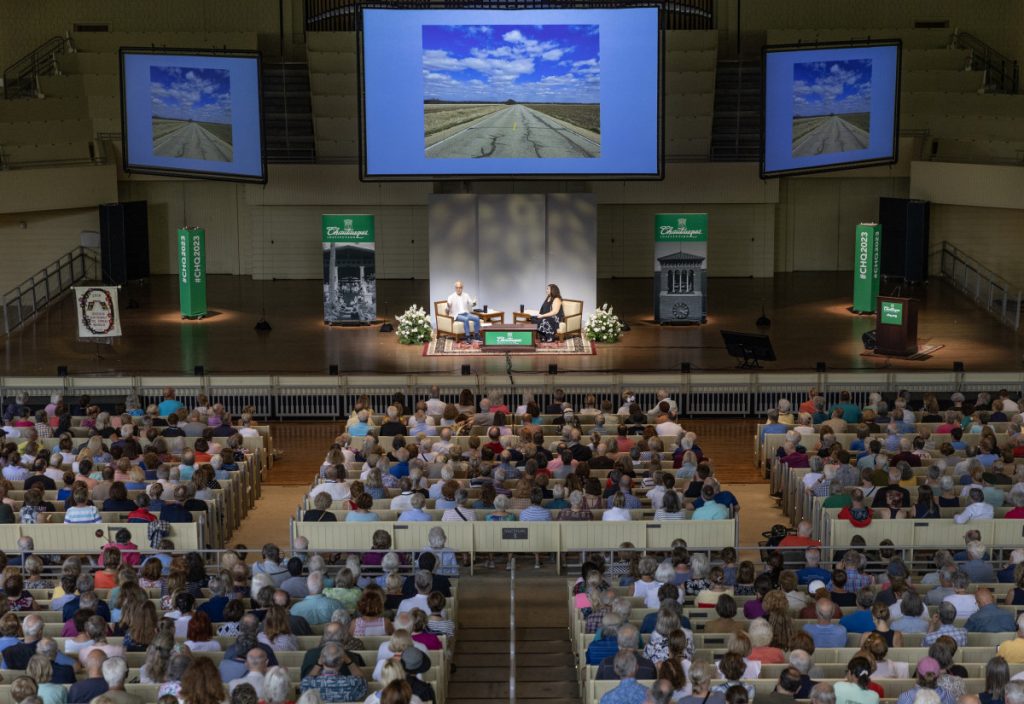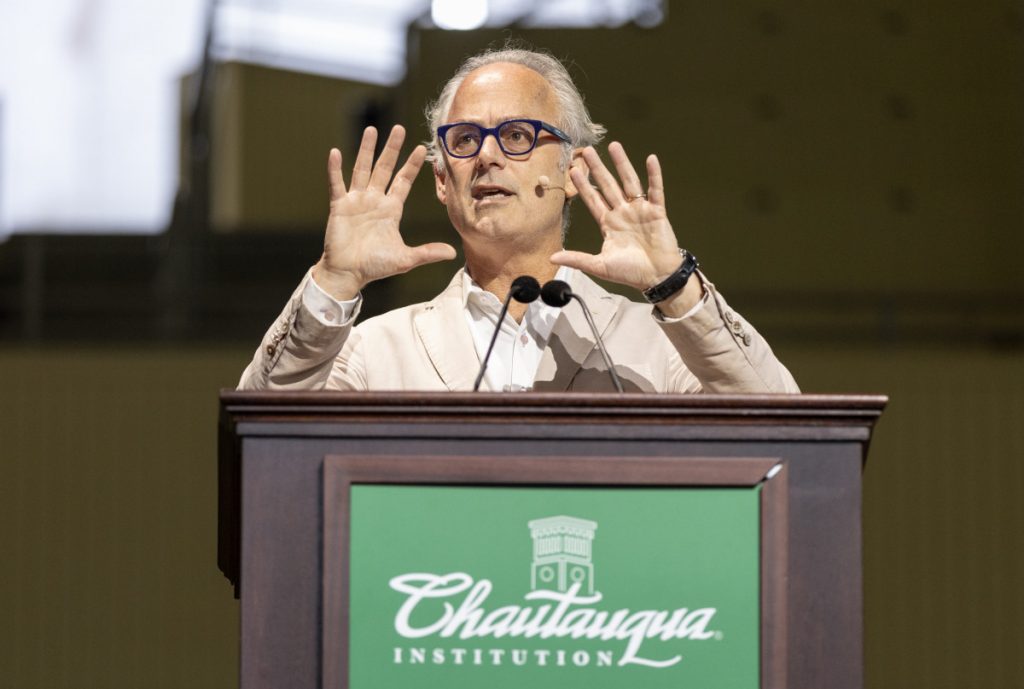
Alton Northup
Staff writer
Journeys are as important as the characters who take them.
“It’s very natural as a storyteller to be interested in the role these roads play, but they really are a landscape to explore the changes that we undergo as individuals,” said Amor Towles.
In his latest novel, the New York Times bestseller The Lincoln Highway, the titular highway is central to his characters’ experiences. Towles discussed the road’s history and its connection to the book at 10:45 a.m. Thursday in the Amphitheater for the Chautauqua Literary and Scientific Circle, and to continue the Chautauqua Lecture Series Week Five theme, “Infrastructure: Building and Maintaining the Physical, Social and Civic Underpinnings of Society.”
In the early 1900s, there were more than 2 million roads in the United States, but with just 10% of these paved, getting anywhere was next to impossible. In a country of millions, an average of 150 people traveled across the country each year and often looked as if they were equipped for an Arctic expedition, Towles said.
“Roads evolved to spiderweb out from communities,” he said. “Roads were not designed to go long distances.”
Then came Carl Fisher.

Fisher spent most of his life in motion, Towles said. Born to a poor family in Greensburg, Indiana, he left school at age 12 to sell tobacco, candy and books on trains. Later, he developed an obsession with bicycles and opened a successful repair shop with his brothers. An apt bicycle racer, his eventual fascination with the speed of automobiles was only natural.
He broke many early land-speed records as an auto racer, and invested in the first patent to manufacture headlights. At the time, his company Prest-O-Lite supplied headlights for nearly every automobile in the country.
In 1909, he joined a group of businessmen for a new project – the Indianapolis Motor Speedway. The common practice at the time was racing on a strip of dirt roads, Towles said, which proved unsafe – and sometimes deadly. Instead, Fisher proposed paving the looped track.
With that, the Indy 500 was born and more than 80,000 people attended the first year, Towles said.
As his wealth grew, Fisher started spending his winters in Miami. While traveling from Indiana to Florida, the automobile lover quickly discovered how difficult it was to navigate the country by road.
“At the time, the federal government had no interest in the road systems in the United States, and so Carl decided there should be a road across the country,” Towles said. “It’s principally a patriotic mission.”
By 1913, he raised enough funds to construct a road stretching from Times Square in New York City to Lincoln Park in California. It was the first transcontinental highway in the country, and he dubbed it the Lincoln Highway. Within a decade, more than 20,000 people were traveling the country by car.
“It was a major change in the way that people saw mobility within their own nation,” Towles said. “Without question, it was the most famous road in America … and then it kind of began to disappear from the American imagination.”
In a way, the highway had designed its own demise, he said. After World War I, a military convoy traversed the road to participate in parades and conduct outreach. The trip was a disaster as the highway struggled to support the 80-vehicle caravan. In the procession was a young Lt. Col. Dwight D. Eisenhower, who made the modern highway project the focus of his presidency.
But Towles is not ready to give up on the road.
“Everything I found out about the Lincoln Highway and its history amazed me,” he said. “It reinforced this notion that in many ways it was the perfect metaphor for many of the themes that were part of the book.”
The Lincoln Highway follows 18-year-old Emmett Watson who takes the road for an unexpected road trip to New York City with two friends from a juvenile work farm. The highway serves as a backdrop to the coming-of-age journey that unravels, following a long tradition of journeys in Western literature, Towles said.
“At its center are individuals,” he said. “They’re at that moment in their lives where they suddenly discover that they have the liberty and the responsibility to begin making a variety of decisions for themselves, such as: What is the difference between right and wrong? What does it mean to be an American? How should I treat others, what should I expect of myself and, ultimately, who is it that I want to become?”
In a way, the Lincoln Highway was also the backdrop for the country’s own coming of age journey.
Towles’ lecture concluded with a conversation with Emily Morris, senior vice president and chief brand officer, discussing his own journey to becoming a writer.
“I began writing as a kid, and I knew I wanted to be a writer when I exited first grade,” he said. “From that point forward, I was writing.”
But a duality of confidence and delusion lived in Towles, one that he said all young creatives face. He carried those feelings with him to Yale, where American novelist Peter Matthiessen was a visiting scholar.
Towles enrolled in his seminar and called it a major turning point after Matthiessen asked him to stay after class. There, he told Towles that he saw potential – maybe even a gift – in his writing.
“It’s a person you admire in a variety of ways seeing something in you that you thought was there but you really had no proof,” he said. “I say to young artists, you don’t need that to happen every year of your life; you need that to happen once every 10 years, because you can carry that for a long time.”
Towles ultimately chose to go into the investment business, where he spent 20 years as an investment manager.
“Peter was sorely disappointed,” he said. “We (had) dinner one night and at the end of the dinner he says, ‘Amor, I’ve got to tell you … when people go to Wall Street, they never come back. So, I think that you should assume that your life as an artist is over.’ ”
Those words from his mentor stuck with him, and he started writing again in his 30s. His first novel took seven years to write.
“At the end of the seven years I didn’t like the book,” he said. “If you spend seven years doing something and you don’t like the outcome, you should reflect on that.”
So he did, and much of his writing process now comes from the lessons of that failed novel. He calls himself a “dedicated outliner,” and will not write a book unless he has the story planned from start to finish. Any book he writes, he said, needs to have a draft within the first year.
“You can spend as many years as you want revising that, but you try to capture the lightning in the bottle that first year and make the most of that,” he said.
The most important thing for a writer, he said, is focusing on the work and not the audience, and referred to the plot of his bestselling novel, the 2018 CLSC pick A Gentleman in Moscow.
“If I really spent a lot of time thinking about how my books would be received from a popular standpoint,” he said, “I certainly wouldn’t have written a book about a guy in Russia who never leaves a hotel for 30 years.”




